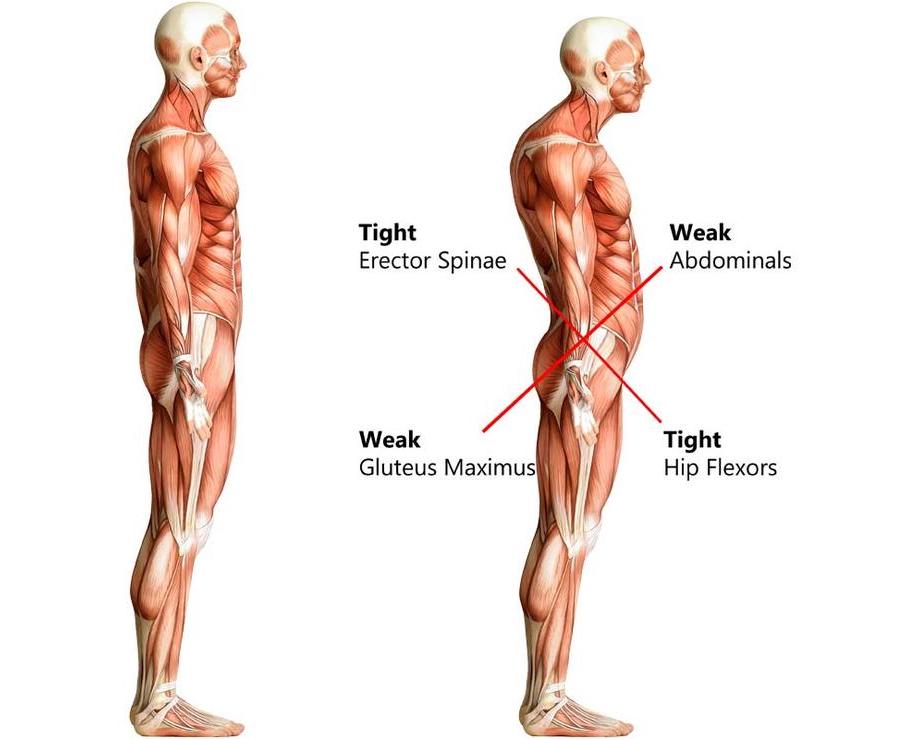Lower cross syndrome (LCS), aka, pelvic cross syndrome or the Unterkreuz syndrome, is similar to upper cross syndrome (UCS) in that it is also a pattern of strength imbalance between the front and back sides of the body. However, as the name implies, lower cross syndrome affects the lower aspect of the torso including the low back, abdomen, and pelvis. If you or someone you know is experiencing discomfort from lower cross syndrome, it can easily be corrected with the support of chiropractic care.
As you may guess, upper and lower cross syndromes are caused by poor posture and are each becoming more common due to an increased sedentary lifestyle including more screen time..
Improving your posture with a lumbar support pillow and getting up and moving more will help minimize the onset of LCS and are both great steps in the right direction – but that’s not always enough.
At Kailua Chiropractic Family Wellness, we help correct dysfunctional movement patterns in the spine and muscles of the body to prevent syndromes like lower cross.
What is Lower Cross Syndrome?
Lower cross syndrome is a muscle imbalance in the lower torso which presents a specific pattern of tight vs. weak muscles that cross between the front and back sides of your low back, abdomen, and pelvis.
The name lower cross syndrome comes from the criss-cross pattern of tight vs weak muscles easily viewed when looking at the body from the side. For example, the muscles of the abdomen tend to weaken and the hip flexors tighten in the front side of the body while the glutes weaken and the low back muscles tighten in the back side of the body.
This strength imbalance between the low back, abdomen, and pelvis gradually creates postural changes in your spine leading to chronic pain in one or more of the affected areas.
What is the leading cause of lower cross syndrome? You guessed it – INACTIVITY! Sitting for long hours tightens the hip flexors which in turn tightens the low back muscles. Eventually, this can weaken your core including your muscles of the abdomen and glutes.
Like UCS, lower cross syndrome also adheres to the “form follows function” rule. What does this mean? How we position and move our bodies daily (sitting, leaning, hunching, or crossing our legs for long hours) can create patterns which limit our ability to function. A Functional Movement Assessment helps the doctor assess where dysfunctional patterns may be limiting the spine and other joints of the body such as in the case of LCS.
The abnormal pattern of tight vs weak muscles in lower cross syndrome creates an anterior tilt in the pelvis which progressively worsens – and your posture responds in a predictable way. From the side view, this presents in the torso as an increased lumbar spinal curve or increased arch in the low back. Eventually, the back and hamstring muscles work harder to compensate for the increased spinal curve which can lead to painful issues such as sciatica, slipped or bulging discs, and/or segmental dysfunction of the lumbar spine.
Signs and Symptoms of Lower Cross Syndrome
Lower cross syndrome can cause problems in your pelvis, low back, sacrum, and legs including:
- Fibrotic changes in the hip joints (arthritis)
- Postural changes including a forward tilted pelvis and increased lumbar curve
- Weak core including muscles of the abdomen and glutes
- Chronic low back and/or hip pain
- Sciatica
- Numbness, tingling, or weakness down one or both legs
- Tight hip flexors (iliopsoas muscles)
- Segmental dysfunction of the lumbar vertebrae
- Decreased range of motion in the low back, hips, and legs
What Causes Lower Cross Syndrome and How Do You Prevent It?
Do you work at a desk all day or enjoy playing video games frequently? You may be at risk for developing lower cross syndrome!
Lower cross syndrome is most commonly caused by a sedentary lifestyle, like sitting at a desk for long periods. It may also be caused by poor posture – or a combination of both.
To prevent lower cross syndrome, stay active, stretch, pay attention to your posture, and take regular breaks when sitting for extended periods.
If you already have lower cross syndrome, exercises that strengthen the weaker muscles and lengthen the tighter muscles can help restore balance and relieve symptoms.
Dr. Cara can start your care for lower cross syndrome in the office with gentle corrections but also recommends restorative stretches at home to prevent your muscles from getting tighter and weaker. Here are a few to try:
Plank:
Planks strengthen your core:
- Start in a plank position with your palms and toes on the floor (advanced position – place forearms on the floor). Align your palms (or elbows) beneath your shoulders and keep your neck, spine, and pelvis neutral (or straight). Keep your neck long and your eyes looking at the floor. Breathe.
- Keep your torso straight and pull your navel in towards your spine.
- Hold this position strong while breathing in and out for 10 seconds.
- Release your body gently to the floor and rest for 15 seconds.
- Repeat 4 times.
Lunging hip flexor stretch:
Stretching the hip flexors can ease tension in the low back and hips:
- Start in a modified lunge position with your right knee bent on a mat at a 90 degree angle beneath your right hip (R knee should align with your R hip). Keep your hips level and step your left foot in front of you, bending your left knee at a 90 degree angle too (L thigh is parallel with the mat).
- Place your hands on your hips and breathe.
- Keeping your back straight and your hips level, rock forward on your right knee (increasing the angles of the right knee and the right hip), moving your hips forward until you feel a comfortable stretch in the right hip and thigh. Continue to breathe and hold the position, or rock forward and backwards to gradually open the right hip even more.
- Repeat on the other side.
Knee to chest stretch:
Cool down with an easy stretch for low back, hips, and hamstrings:
- Start by lying on your back with your hips level and your right knee bent.
- Keep your left leg straight and draw your navel in toward your spine as you grasp your right knee and pull it toward your chest.
- Hold and breathe for up to 2 minutes.
- Repeat on the other side.
Bridge:
Bridge strengthens your back and hip muscles and helps stabilize your spine:
- Lie back on your back with your knees bent, feet flat on the floor, and your arms along your sides with your palms down.
- Push your heels into the mat and lift your hips into the air until your torso is in one straight line from your chin to your knees. Rest on your shoulders with your neck relaxed and long. Breathe.
- Squeeze your glutes and lift your hips a little further toward the ceiling.
- Breathe and hold briefly, then safely lower your torso to the ground and rest.
- Repeat 10 times, or until you feel stretched.

How We Treat Lower Cross Syndrome at Kailua Chiropractic Family Wellness
At Kailua Chiropractic Family Wellness, Dr. Cara takes a whole-body approach to facilitate the body’s natural healing process.
During your first appointment, Dr. Cara performs a thorough physical exam, discusses your medical health history, and begins working on the affected areas in lower cross syndrome.
She may use gentle chiropractic adjustments, myofascial soft tissue therapies, and active release techniques to help you find immediate relief. Most patients leave their appointment feeling better and reporting decreased pain and increased range of motion.
Why wait when you or a loved one can enjoy a better quality of life without the pain and stress of lower cross syndrome? Try something new that works!
If you think you or a loved one could benefit from Dr. Cara’s gentle chiropractic care in beautiful Kailua, Hawaii, call us at 808.262.2226 or book an appointment with Dr. Cara today.

